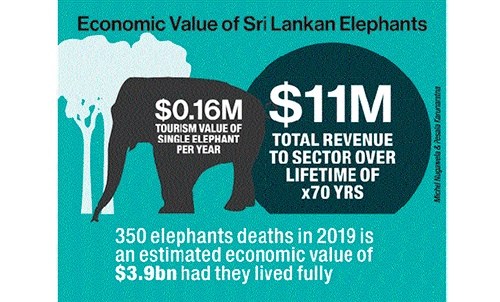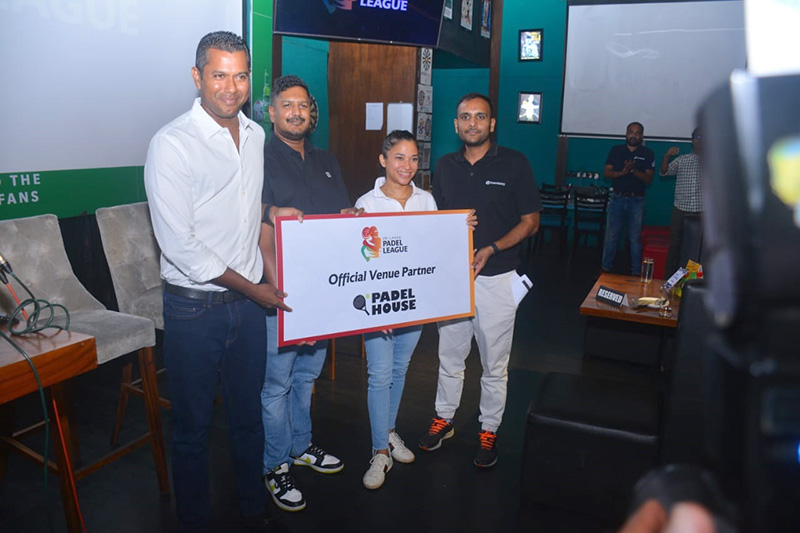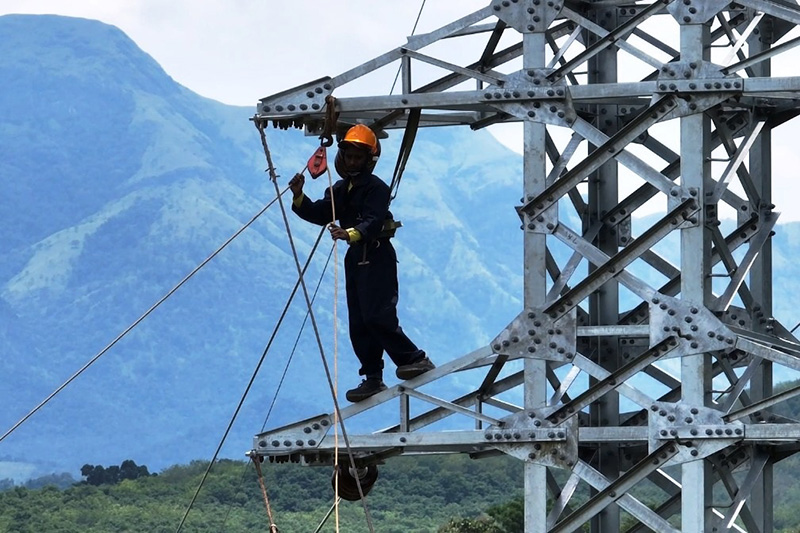Business
A cut tree, a dead elephant, is a lost tourism dollar in the future

by Michel Nugawela and Pesala Karunaratna
(Continued From Last Week)
To increase occupancy rates and avoid economic losses during off-peak seasons, mass tourism suppliers also rely heavily on all-inclusive packages. By inviting tourists to leave their wallets at home and remain within the hotel (typically, the pool, bar and restaurant), they inhibit the dispersion of economic benefits to wider communities or the economically disadvantaged.
For example, mass tourists venturing out of their segregated enclaves to ‘do’ Sigiriya, Polonnaruwa, or Anuradhapura shuttle point-to-point between iconic sites and resorts in the round tour circuit. Individuals and businesses (such as the restaurants, shops, and local transportation services in the vicinity) that aren’t fortunate enough to be part of a package that grants access to this self-contained world receive zero to limited economic benefits. (Studies of all-inclusive packages internationally show that only about 10% of tourism spending directly benefits the local economy.)
Most – if not all – mass tourism suppliers in Sri Lanka also acquire the majority of their business through foreign operators, whose tactics of choice include pitting hotels and resorts against each other to secure the cheapest room rates. It’s much the same with destinations. For example, Lonely Planet’s ‘Best In Travel’ listing ranks its top destinations, regions and cities to visit each year. Sri Lanka took the top spot in 2019 – much to the sectors elation – and yet bear in mind that no single destination is featured in any two consecutive years. Countries are elevated one year, only to be tactically removed in the next. Foreign tour operators also promote destinations to prospective customers – once again, a different destination (or list of destinations) each year – ensuring bargaining power against suppliers/destinations remain stacked in their favour (and with it a high dependency on their global brands, markets, and channels).
Even as the tourism sector languishes through the Covid crisis – which, if anything, should motivate a meaningful search to curtail its own unhealthy overreliance on mass tourism markets – there is still no specific strategy or objective to address the non-differentiation of Sri Lanka’s tourism product. This is not entirely surprising; when footfall is high, the mass tourism sector replicates more of the same; when demand is low, it discounts prices instead of differentiating the product. In a crisis, it simply has no response to the need for better tourists, and a better distribution of tourist by season or location, for the destination.
The untapped potential of alternate tourism
The global tourism sector is expected to return to pre-pandemic tourism levels by 2024 – a slow and lengthy recovery period that has significantly impacted the mass tourism segment. Many consumers have lost wages or jobs, and since travelling will take a larger share of their disposable income, it is extremely unlikely that a rebound in visitor flows will equate with a recovery in visitor spending (expect more cheap all-inclusive packages to lure more cheap tourists). According to international research, the travel behaviour and preferences of the mass tourist will also look different in the future as they take fewer, more memorable trips, with a greater demand for experiences in the outdoors away from crowds.
Meanwhile, high value travellers – the segment Sri Lanka has consistently overlooked in its drive for ‘more’ (volume over value/quantity over quality) – will continue to travel in significant numbers as global mobility returns in 2021. Yet here too, their motivations and behaviours converge on the need for unique and meaningful experiences in nature and wildlife – again, where Sri Lanka has failed to develop and differentiate its product.
Many countries have used the pause this year to rethink their business as usual model and search for answers to important questions such as: will the post-Covid tourists be the kind of visitor we want? Will they improve seasonal spend, stay longer, and disperse economic benefits further into local communities? New Zealand, for example, is ‘reimagining tourism’, with key stakeholders arguing for a value over volume approach to managing tourism numbers while they await an industry recovery. Tourism is New Zealand’s biggest export industry, contributing 20.4% of total exports or 5.8 % of its GDP in 2019.
Meanwhile, Tourism Australia has identified a market opportunity of 80m high value travellers globally, of whom 32mn consider Australia as a destination to visit in the next four years. ‘Nature & Wildlife’ is the #1 driver of destination choice for this demographic from their 14 key inbound markets. This bears repeating: 72% Chinese, 73% Indians, 63% Indonesians, 76% Japanese, 66% Singaporeans, 67% South Koreans, 79% British, 63% US, 74% Germans, 68% Hong Kongers, 65% Malaysians, and 73% New Zealanders from the high value traveller segment visit Australia to experience its nature and wildlife assets.
Malaysia acknowledged the natural wealth of its country to drive revenue even earlier. In 1996, it published its National Ecotourism Plan to attract more visitors and increase visitor spend by developing competitiveness in its nature and wildlife assets. In 2002, nature and wildlife tourism established 10% of the country’s tourism sector; by 2019, this had tripled to 30.4%.
$11m is a wild elephant’s lifelong intrinsic value to tourism
We can no longer be blind to what we are most blessed with. Instead of playing to our strengths, we continue to run a race in a global tourism market where the ten major destinations attract 70% of the worldwide tourism market. It is now time to match our best assets – nature and wildlife – with the best tourists – the high value traveller. And this can be done. Our natural landscapes and attractions boast of the richest species concentration in Asia and one of the highest rates of biological endemism in the world, for both plants and animals.
Consider the wild elephant population: 70% roam outside the protected areas, offering the best viewing opportunities in Asia and representing a huge revenue stream for the tourism sector. We determine the tourism value of a single elephant, alive, to contribute $0.16mn per year. Since elephants live for up to 70 years, the total revenue that a single elephant can generate is immense – $11mn over its lifetime to our hotels, resorts, airlines, travel companies, and – potentially – local economies.
We say potentially, because the value per elephant is significantly diminished under the mass tourism model, where the asset is perceived as an irrelevant pest rather than an important generator of profits. (Conversely, these assets are precisely what high value travellers – who outspend mass tourists by 3-4 times – value most). As global demand rises, therefore, Sri Lanka’s supply diminishes: 350 elephants perished in 2019 – an estimated commercial loss of $3.9bn to the sector, which is the value the animals would have distributed among the recipients in the tourism sector had they lived their lives fully.
Deforestation also dismantles the very assets – animal or plant, elephant or forest – that are required for a product differentiation strategy. When ancient migratory corridors are disrupted, elephants will die. When forests are uprooted, we will no longer be ‘green’ – a fundamental driver of destination choice for high value travellers. When the damage is done – when our natural assets are stripped away – Sri Lanka will no longer be able to position itself as anything other than a cheap destination for sun-sea-sand tourism. The entry of international budget hotel chains over the past half-decade point to our destination relevance in the future.
Amid the increase in deforestation, the silence from the mass tourism sector is deafening, revealing, firstly, just how disconnected its suppliers are from the wider ecology within which they operate, and secondly, the poverty of their vision for the sector and country.
It should come as no surprise, then, that disruption to the mass tourism model has come from the market’s edges rather than any single operator within the mass tourism sector. Dilmah has brought its compelling vision and business strategy to compete against commoditization in the tea industry to the tourism sector. Its luxury offering can generate eight times more revenue per tourist than the mass tourism offering, indicating the potential Sri Lanka has to pivot from mass to class and drive revenue as a destination.
We would question whether it is even possible to carve out other profitable niches without building on Sri Lanka’s strengths in nature. Consider the wellness segment which reconnects consumers to nature through the restorative benefits of ayurvedic medicine and Hela Wedakama, the mindfulness meditation techniques of Buddhism, and yoga retreats. In a short span of time, the segment already accounts for $180mn export revenue (while the spices sector, which has existed for centuries, accounts just $300mn).
A reality check
Sri Lanka is weak or entirely lacking in the underlying enablers of export competitiveness. Without improved FDI flows, the government remains incapable of single-handedly investing in infrastructure and injecting working capital to promote export-driven businesses.
Allocating forest-land to export development (and as the twelve BOI export processing zones remain largely unutilized) dismantles the only competitive advantage Sri Lanka has to compete in international markets and become the primary source of foreign exchange for the country.
By stripping away our nature and wildlife assets, we are left with only our beaches and reputation for cheap sea-sun-sand tourism. The tourism sector is therefore not a fringe player in what happens next – it is right at the centre, because it is these very assets that enable its future competitiveness. We must now urgently commit to a diverse tourism portfolio targetting different tourism segments. A cut tree, a dead elephant, is a lost tourism dollar in the future.
Business
IceWarp expands into Sri Lanka, fostering European innovation in collaboration with FentonsIT

IceWarp, a global leader in business communication solutions, has officially launched its cutting-edge platform in Sri Lanka, bringing European expertise in email and collaboration solutions to support the country’s evolving business landscape.
This expansion is driven by a strategic partnership with Fentons Information Technology (FIT), the Information Technology arm of Hayleys Fentons Limited.
The grand launch event held at The Kingsbury Colombo on 4th April, 2025, was graced by several distinguished guests, including Chief Guest Mohan Pandithage, Chairman and Chief Executive of Hayleys PLC.
The presence of Adam Paclt, Global CEO of IceWarp, and Pramod Sharda, CEO for India and the Middle East of IceWarp, along with their global team, highlighted the significance of this expansion. Industry experts, government officials, corporate leaders, and CIOs from the banking, financial services and insurance sectors were in attendance as well, reflecting strong local interest in IceWarp’s European expertise.
With this launch, Sri Lankan businesses now have access to an affordable, scalable and secure alternative to Microsoft 365 and Google Workspace. IceWarp’s advanced Collaboration Suite integrates a wide range of tools into a single, unified platform designed to streamline communication and boost productivity. Offering flexible hybrid deployment options and cost-efficient solution, IceWarp enables organisations to optimise their operations without compromising security or functionality.
Business
Eventistry Sports launches Sri Lanka’s inaugural franchise padel league

Eventistry Sports, a trailblazer in innovative sporting events, has unveiled the Sri Lanka Padel League (SLPL), the nation’s first franchise-based padel tournament, set to debut in June 2025. This groundbreaking league promises to redefine Sri Lanka’s sports landscape by creating a dynamic national platform for athletes while fostering unity among fans, brands, and communities.
The SLPL will showcase six franchise teams, each embodying the spirit of iconic Sri Lankan locales: the Colombo Chargers, Yala Rangers, Hikkaduwa Riders, Ella Hawks, Arugambay Vipers, and Trinco Warriors. These teams will not only ignite regional pride but also unite the country through a shared passion for padel—a fast-paced racquet sport merging tennis and squash, played on enclosed courts.
“The SLPL is more than a league; it’s a movement,” declared Karin Wijeratne, Director of Eventistry Sports. “By blending franchise sports with Sri Lanka’s vibrant culture, we’re creating a platform where players gain national recognition, fans rally behind their hometown heroes, and brands engage with communities in meaningful ways.”
The league’s launch on June 21–23, 2025, at Colombo’s Padel House courts (CR&FC) will kick off with three days of high-octane matches, preceded by a star-studded player auction on May 16th at The Vault, Colombo City Centre. Local talent—both professional and intermediate—will be drafted by franchise owners, with international registrations now open to elevate the competition’s global appeal.
Please log in to: www.slpadelleague.com and social media: @SriLankaPadelLeague (Facebook & Instagram) for more information.
Business
Ceylon Energy and HJT China complete key power projects under SESRIP in Sri Lanka

Ceylon Energy and HJT China have successfully completed the Mahiyangana-Kappalthurei 33kV power distribution lines and the Uhana Gantry as part of Sri Lanka’s Supporting Electricity Supply Reliability Improvement Project (SESRIP). Funded by the Asian Development Bank ($42 million), SESRIP aims to expand energy access in underserved regions, including conflict-affected areas and provinces like Uva and North Central.
The project’s infrastructure spans over 270 km of 33kV lines, 13 switching gantries, and 2,372 km of low-voltage extensions.
The projects connect 35,000+ households and improve reliability for 493,000+ consumers; integrates renewables to reduce losses.
The projects’ notable components include: Mahiyangana-Bibila Line: 36 km with 147 steel towers and Kappalthurei-Sixth Mile Post Line: 14 km with 58 towers.
Ceylon Energy Chairman Madushanka Fernando hailed it as a ‘new beginning of a brighter era’, emphasising the project’s role in uplifting rural communities and driving sustainable development.
The initiative underscores Sri Lanka’s commitment to inclusive, reliable energy and climate resilience.
-

 Features1 day ago
Features1 day agoStarlink in the Global South
-

 Business2 days ago
Business2 days agoDaraz Sri Lanka ushers in the New Year with 4.4 Avurudu Wasi Pro Max – Sri Lanka’s biggest online Avurudu sale
-

 Business3 days ago
Business3 days agoStrengthening SDG integration into provincial planning and development process
-

 Business2 days ago
Business2 days agoNew SL Sovereign Bonds win foreign investor confidence
-

 Sports4 days ago
Sports4 days agoTo play or not to play is Richmond’s decision
-

 Features1 day ago
Features1 day agoModi’s Sri Lanka Sojourn
-

 Latest News6 days ago
Latest News6 days agoIPL 2025: Rookies Ashwani and Rickelton lead Mumbai Indians to first win
-

 Sports3 days ago
Sports3 days agoNew Zealand under 85kg rugby team set for historic tour of Sri Lanka











